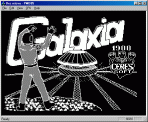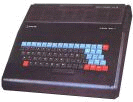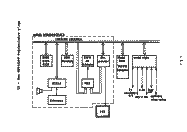| |
|
|
|
|
|
|
|
|
(c) Schotek 2010
|
| 23.9.2019 | | | Doplněny informace o emulátorech v roce 2019 |
| 28.11.2009 | | | Na stránku software doplněno ZX demo Spectrology 1 a Simpsons |
| 14.8.2009 | | | Doplněno zapojení kabelu k XY4140 | | 27.6.2009 | | | Doplněny informace o MFD 85 a pár fotek na stránce periferií | | 28.1.2009 | | | Doplněny informace o monitoru PMD 60 | | 2.1.2009 | | | Aktualizován odkaz na emulátor PMD 85 od Petra Tůmy | | 23.5.2008 | | | Doplněny informace o originálních periferiích PMD 50 a PMD 70 | |
| |
|
This page is dedicated to PMD 85 - my favorite 8-bit personal computer.
It was developed in 1983 by ing. Roman Kiss and Stefan Toth (Czechoslovakia) and produced by Tesla Piestany (and Tesla Bratislava later).
PMD 85 It is not a clone of some other popular computer.
PMD 85 was based on clasic Intel 8080 scheme with patented technology for sharing memory between processor and videologic.
PMD 85 was composed from several independent boards - baseboard, keyboard, I/O board and ROM module.
There were three versions of PMD 85 and several clones.
| |
PMD 85 was one of first 8bit computers that I meet.
On the PMD 85 I was writing my first programs in Basic, machine code and assembler (do you know, what's the difference?).
| |
After many years I return to PMD 85 by a little curious way.
I want to create emulator Atari 800 on PC, but hardware of Atari is more complicated than hardware of PMD and I want to try how to create emulator
because I want to use my old programs on PC.
I was create first version on PC 286AT (12MHz) in 1995 and I try to optimize emulation (written allmost in pure assembler) for speed.
Emulation of PMD on 12MHz 286 was run on 60 percent of original PMD 85 speed.
Later I need to slow down speed of emulation, because newer computers are too quick and this is why the DOS emulator PMD sometime hangs.
Actual Windows version is completely new and I use only base idea from my first DOS emulator.
Windows emulator also can emulate different versions of PMD 85 and some of his clones.
Second generation of my PMD 85 emulator for Windows is still under development.
|
I'm not the only one author of PMD 85 emulator.
 Here is some of authors of PMD 85 emulator:
Here is some of authors of PMD 85 emulator:
| |
Software for PMD 85 was produced in many organizations and firms. Sometime it was very special programs, because PMD 85 has many input and output ports and PMD can drive different machines (plotters, robots...)
Many programs and games was created in 4004/482 base organization of Svazarm, especialy from Karel Suhajda.
Important authors also was trio Vesely Bedrlik Gavar (VBG software) and Ceres Soft (Petr Tuma).
| |
Here is photogallery of PMD 85. (20. 11. 2002 added new photos)
|
History of hardware PMD 85:
- PMD 85 - the very first version

- Author of this 8bits computer was ing. Roman Kiss from Tesla Piestany.
- White prototype box, that I seen only on photos. On some photos I have seen green colour version.
- Size was almost the same as size of newer version.
- It was based on clasic Intel 8080 scheme with added I/O chips (several 8255, 8253, 8251) and monochrome video logic.
- PMD 85 (sometime labeled as PMD 85.1)

- This version was produced in Tesla Bratislava and there was really serial production.
- It looks like most version of PMD 85
- Not very good keyboard.
- Not very good reading of data from cassette recorder.

- Memory map
- 0000 až 7FFF RAM
- 8000 až 8FFF ROM (Monitor - 4KB)
- 9000 až 9FFF nothing
- A000 až AFFF ROM (Monitor - mirrored 8000-8FFF, maybe simply address decoder)
- B000 až BFFF nothing
- C000 až FFFF Video RAM

- It was build from several independent modules
- Base board with CPU, RAM, control logic, keyboard logic and video logic.
(I have also electronic scheme)
- Keyboard module with optional hardware autorepeat.
- Interface module with powered BUS, two 8255, counter 8253, serial interface 8251 (V24/IFSS and cassette recorder). (I have scheme)
- Changeable ROM module with BASIC (sometime Pascal or Assembler). There was several free slots for adding of ROM chips (for example drivers for printers).
- Can be added module for colour output on monitor (TV modulator was BW). With this module can be used 5 colors from 256.
- PMD 85.2

- Better keyboard with software autorepeat
- Complettely new system software
- New Basic-G/2.0
- Different scheme of cassette recoder interface (very good) with software decoding of data.
- Four colour video output, but grayscale on TV.
- PMD 85.2A
- New motherboard with added 8kB of RAM (56kB total)
- Changed Basic for use added memory
- PMD 85.2B - internal label of producer, outer was labeled as 2A
- Almost the same scheme, but 64kbit modules used (16kbit in 2A)
- PMD 85.3 - last version of PMD 85 (1988)
- New motherboard again. All 64kB of memory can be used for programs. 8KB "BIOS" was switchable to address space E000 to FFFF. Layout of motherboard is radically changed.
- New version of changeable ROM module - now use 2KB ROM chips, standard is 5 chips with 10kB BASIC G/V3.0, can be used max. 16 chips (32KB)
- Some little changes in software for use new version of hardware
- Video and TV output was colour
- Added font table for all czech and slovak characters (some version has russian fonts)
- Didaktik Alfa (clone of PMD 85.1)

- Producer of this clone was Didaktik Skalica
- Changed (simplified) electronic scheme (no changeable ROM module with Basic, Basic was integrated in unused part of memory map)
- Simplified address decoder for I/O - changed address of tape interface
- Software was almost the same as in PMD 85.1 - changed was only some details - different address of tape interface, different start of Basic and system logo was changed to * DIDAKTIK ALFA READY *
- Didaktik Alfa 2 (clone of Didaktik Alfa inspired by PMD 85.2)

- Producer of this clone was Didaktik Skalica
- Changed electronic scheme again - use different size of ROM modules
- Newer system software and Basic (like in PMD 85.2, but updated)
- Added power on selftest
- Added font table for all czech and slovak characters
- The same design of case as first version of Didaktik Alfa
- Mato (clone of PMD 85.2)

- Producer of this clone was firm Statny majetok Zavadka
- It was kit for home built computer in smaller case
- Simplified scheme without changeable ROM module and without IO interfaces (IO is only one "service" 8255)
- Changed layout and electronic scheme of keyboard
- Changed software and it was not compatible with PMD in tape data format
|
There was available many peripherial devices, because PMD 85 has many IO interfaces.
It was printers, plotters, joysticks, casette recorders, floppy, other computers (Atari, ZX-Spectrum, PC), industrial robots and more...
There is some official peripherial devices for PMD 85:
- PMD 10 - Switching power supply for PMD 85 - replace for older EA 1605
- PMD 30 - Floppy device with use Intel 8271. First version has 87kB of data on single side 5.25" floppy disc
- PMD 40 - Module for EPROM programming
- PMD 60 - Black and white monitor (simplified TV Tesla Merkur)
- PMD 60.1 - Green screen version of PMD 60
- SP 210 - casette data recorder with manual and ttl control of play, record and other
- SP 210 T - The same as SP 210 with added dot matrix printer with only one dot :-) It was very slow printer...
|
Schemes and technical specification that I have:
- Scheme of PMD 85
- Scheme of PMD 60.1 (green monitor)
- Scheme of SP 210 (cassette recorder)
- Scheme of BT 100 (one dot printer)
- Scheme of K 6304 (thermotransfer printer from Robotron)
- Datasheet of cable for plotters XY 4140 a 4150 (Laboratorni pristroje Praha)
- Scheme of M 710 A (cassette recorder)
| |
This page is not complette, sometimes You can found new informations here.
Look for timestamp at head of this page.
Sorry for my english.
Informations, questions and suggestions please send to martin @ schotek . cz
. Thank you.
|
|
 Here is some of authors of PMD 85 emulator:
Here is some of authors of PMD 85 emulator: (Version 3.12.2002 7:40) - emulate all versions of PMD 85 and clones Didaktik Alfa and Mato :-)
(Version 3.12.2002 7:40) - emulate all versions of PMD 85 and clones Didaktik Alfa and Mato :-) 




